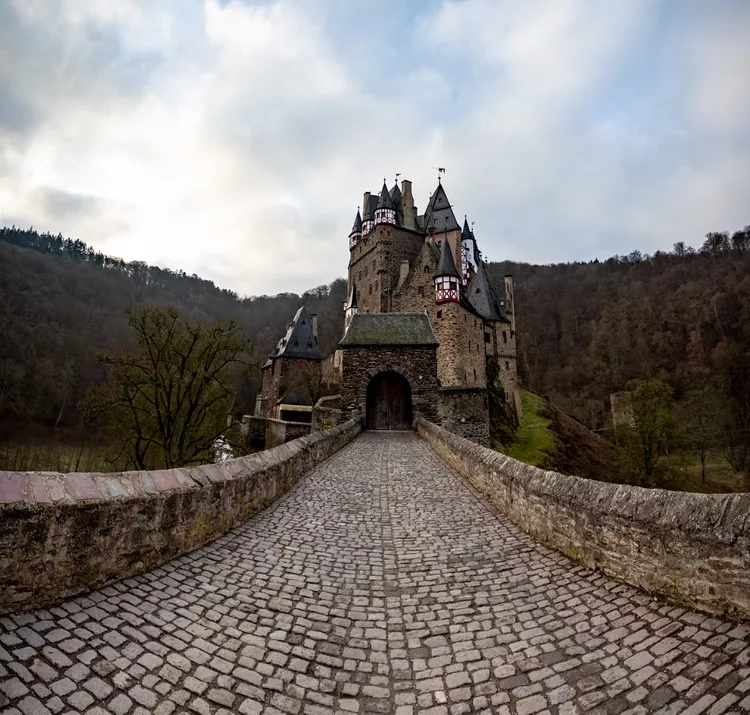Summary of Burg Eltz Castle
Burg Eltz Castle: A Charming Fortress in Germany
Burg Eltz, or Eltz Castle, is one of the most enchanting castles in Germany, nestled in the west between Koblenz and Trier and surrounded by the scenic Moselle River. Visitors are often captivated by the sight of this fairytale castle perched amidst lush trees.
The Eltz family has resided in this historic castle since the 12th century, proudly maintaining a lineage of 33 generations.
Attractions of Burg Eltz
Guests can stroll through the grounds where the castle rests on an oval rock, standing 70 meters above the valley floor. The distinct shape of the castle corresponds to its intriguing foundation.
Guided tours provide insights into life in a medieval castle, showcasing elements such as the unique medieval plaster that comprised oxblood, animal hair, clay, quicklime, and camphor. With eight floors, eight turreted towers reaching heights of 30 and 40 meters, and around 100 rooms, the castle is a treasure trove of history.
The Romanesque keep, Platt-Eltz, remains the oldest part of the castle, accompanied by four stories of former Romanesque pallas (living quarters). Notably, nearly half of the rooms are equipped with fireplaces, ensuring comfort during colder months, which was quite luxurious for that era. In addition, the castle features the oldest painted chimney in Germany. Tours conclude in the kitchen, where a medieval refrigerator—a cupboard creatively carved into the cool rock face—can be found.
In addition to its historical decor, Eltz Castle houses a museum featuring an impressive assortment of original furniture and artwork. The Knights Hall is home to armor from the 16th century, while the original treasure vault can be explored independently from 09:30 to 18:00. For visitors seeking refreshment, there is a restaurant and a gift shop offering souvenirs.
Beyond the castle, several hiking trails in the Eltz Woods provide opportunities for outdoor enthusiasts. For those looking for a more athletic challenge, a hike to nearby Burg Pyrmont offers a 2.5-hour adventure. Interestingly, despite its numerous unique features, Eltz Castle remains a bit of an insider secret, with fewer crowds compared to other popular castles in Germany.
:max_bytes(150000):strip_icc():format(webp)/BurgEltz5-bca2f985dfa044feb5a82c764d2c11ec.jpg)
History of Eltz Castle
Eltz Castle is a remarkable fortress that has stood the test of time. It experienced only one attack in its long history, yet it was never captured, preserving its integrity for today’s visitors.
Initially recognized via a deed of donation in 1157 by Emperor Frederick I Barbarossa, with Rudolf von Eltz serving as a witness, the castle occupies a crucial location along the Roman trade route from the Moselle Valley to the Eifel region. It was developed through the collaboration of three local lords from the historically significant families of Kempenich, Rubenach, and Rodendorf. The castle’s construction began with the Platteltz keep, followed by additions from the Rübenach section in 1472 and the Rodendorf section between 1490-1540, culminating with the Kempenich section built in 1530. Essentially, Eltz Castle is three castles in one.
In 1815, the independent sections of the castle were unified under the House of the Golden Lion, represented by the Kempenich descendants who outlasted the other noble families associated with the castle.
Visitor Information
- Address: Burg Eltz, 56294 Münstermaifeld
- Transport: Access to Burg Eltz is typically by car, motorbike, or bus. Most visitors arrive from Münstermaifeld and Wierschem. A novel public transport service, the ÖPNB Burgenbus (Line 330), operates four times a day from May to October, only on weekends and public holidays.
- From the parking area, guests can either walk up the hill to the castle or utilize a shuttle bus (costing €1.50).
- Recommended base cities: Koblenz & Trier
- Website: http://burg-eltz.de/en/
Tours of Eltz Castle
Guided tours in German commence every 10-15 minutes and last approximately 35 to 40 minutes. Tours in English, French, and Dutch can be arranged in advance by contacting the castellan’s office. Typically, the maximum wait time is around 30 minutes. Language information sheets are readily available for those accompanying a German tour.
Please note: Photography within the rooms and chambers is verboten (forbidden).




